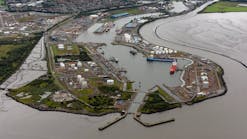New Norwegian gas supplies to continental Europe scheduled for 1993 are uncertain following the sinking off Norway of Den norske stats oljeselskap AS's concrete gravity substructure for East Sleipner field.
The 1.3 billion kroner ($194 million) structure, with a displacement of 560,000 metric tons, was undergoing submersion tests by Norwegian Contractors AS when water rushed into one of the four concrete legs.
Within minutes the structure sank in 230 m of water.
Sleipner A platform was the centerpiece of the joint Troll and Sleipner gas fields development project in the Norwegian North Sea. Beginning in 1993 Sleipner would have been the hub of a new pipeline system to Europe delivering 148 bcf of gas to customers in France, Austria, Spain, Holland, and Germany in its first year.
Statoil hopes to have a replacement Sleipner platform ready to begin production in late 1994 or early 1995.
It said the lost Sleipner volumes can be replaced by stepping up deliveries from other fields in the Norwegian North Sea. A preliminary evaluation shows there should be enough gas to fill the Sleipner gap for 15 months or more with added compression on the Statpipe gas system and modifications to the Zeepipe line, currently under construction.
As a precaution, Statoil also is investigating short term gas purchases from other European producers.
WHAT HAPPENED
The sinking occurred during a test to ballast the concrete base and its four columns down to 20 ft of seaboard before mating to the fully outfitted deck.
Tests were being conducted in the Gandsfjord outside Stavanger and near the dry dock and slipforming area where Norwegian Contractors built the structure. The operation has been conducted successfully on 11 previous concrete platforms built by Norwegian Contractors.
Ballasting is carried out slowly at about 6 1/2 ft/hr.
The 22 persons on board the structure at the time, all evacuated safely, reported hearing a loud noise from one of two shafts outfitted for drilling. The leg began to fill at rates of as much as 6 1/2 fpm and the unit sank in less than 15 min.
During this type of test, minor leaks in the shafts are frequently recorded through steel tubes that run through the concrete. The structure is then deballasted a few meters and the leaks plugged.
The inflow of water on this occasion was so great emergency pumps could not handle the volume.
The base and legs imploded as the structure sank into water depths that exerted forces 2 1/2 times design specifications. Shock waves from the implosion were felt throughout Stavanger and registered 2.8 on the Richter scale at an earthquake recording center in Bergen, about 100 miles north.
Video film of the impact site shows debris strewn around the bed of the fjord. All that is left of the central part of the 360 ft high structure is a mass of reinforcing steel about 32 ft high.
Lloyds List, a London shipping and insurance newspaper, said 30% of the loss on the gravity base was uninsured. While oil company partners in the project-Statoil, Esso Norge AS, Norsk Hydro Produksjon, Elf Aquitaine Norge, and Total Marine Norsk-carry insurance, the Norwegian state's direct 29.6% interest was not insured.
Norwegian Contractors said the extent of the damage would make it impossible to determine the cause of the incident by examining wreckage. The company is checking documentation for the design to establish theories for the sinking.
Statoil also is conducting an inquiry into the reasons for the sinking. A replacement substructure will not be ordered until the possibility of any fault in the design has been eliminated.
Meantime, Norwegian Contractors is clearing space in its dry dock. Work on a new unit could begin in October or November.
REPLACEMENT GAS
Statoil has identified five fields as potential sources of replacement gas for Sleipner. Injection gas and the gas cap in Statfjord field could make a substantial contribution, along with gas from the second phase of Gullfaks field development, Veslefrikk, Heimdal, and Tommeliten.
With the exception of Tommeliten, which is connected directly to Ekofisk, all the other fields feed gas into the Statpipe line. Statoil said more compression would be needed at the Karsto terminal, north of Stavanger, to handle increased volumes.
This gas could be diverted from Statpipe into Zeepipe, now under construction, so Troll-Sleipner partners could meet contract obligations to begin gas deliveries through the Zeebrugge, Belgium, terminal in October 1993.
The original Zeepipe project called for a 500 mile, 40 in. line from Sleipner to Zeebrugge. Work on this line started this year and is to be complete next year on schedule.
A 25 mile, 30 in. section of line has been laid between the Sleipner platform site and the 16/11S riser platform on the Statpipe line, linking Statfjord and Heimdal fields to the Norpipe system with its terminal at Emden, Germany.
The spur line would have allowed Sleipner gas to move to Germany through Statpipe-Norpipe.
Statoil is considering modifications to the 16/11S riser platform to allow gas to flow from Statpipe through the spur to a new riser platform in Sleipner, where the 40 in. line to Zeebrugge will begin.
Statoil said there will be enough time to build a steel jacket riser platform for test production of gas through Zeepipe in summer 1993, with contract deliveries to begin the following October.
The new riser platform also could serve the proposed Europipe project approved by the Norwegian government this year. The 403 mile gas pipeline is to start up in 1995.
No decision has been made on the future of the 140 mile, 20 in. condensate line to transport liquids from Sleipner to the Karsto gas processing plant.
Gas from Sleipner will be followed by deliveries from giant Troll field in 1996. This will require a 184 mile, 40 in. extension of Zeepipe to the Troll onshore gas terminal at Oygarden, north of Bergen. The line is to start up in 1996.
When Troll-Sleipner contracts are running at maximum throughput in the early part of the next century, European customers will receive about 1.27 tcf/year.
Statoil plans to proceed with a subsea development for the Loke satellite of Sleipner, which won government approval this year, and with West Sleipner field, which has 4.7 tcf of reserves.
West Sleipner is to start up in 1996 and for the first 5 years of its life produce 480 MMcfd of gas to replace East Sleipner gas that will be reinjected into the reservoir to maintain and then increase liquids production.
Copyright 1991 Oil & Gas Journal. All Rights Reserved.


